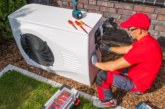
Six years from now the UK will be entering a new era of utilities infrastructure. With government announcing a ‘future homes standard’ mandating the end of fossil fuel heating in new-builds from 2025, low carbon heating technologies, in particular ground source heat pumps, will be looked upon as the new standard for heating much like we view gas boilers today, says Simon Lomax, CEO of Kensa Group.
The ambition to achieve the Committee for Climate Change’s recommended 2,500,000 heat pump installations by 2030, compared to the current installed estate of around 20,000, requires some transformational measures.
Ground source heat pumps (GSHPs), connected to ‘shared ground loop arrays’ (SGLAs), are an alternative form of sustainable heating infrastructure already rivalling and replacing the gas grid. Whilst GSHPs and SGLAs offer a framework for sustainable infrastructure to fulfil the 2025 ‘fuel switch’, their benefits are equally valid for existing homes looking to benefit from the lowest carbon and lowest running cost heating system today.
The Renewable Heat Incentive (RHI), in place until the end of 2020/21, offers significant financial assistance to early adopters of low carbon heating technology. By installing individual GSHPs into each dwelling connected to a SGLA, the system owner will receive 20 years of quarterly Non Domestic RHI payments.
SGLAs provide a long-lasting legacy for the subsidy spend so there is some possibility that support may extend beyond the life of the RHI. In the meantime, the RHI provides financial support to fund the ground array or, for customers who do not want to commit the capital (and wait for the ‘drip-drip’ reward of the RHI), funders are emerging to own and maintain the ground array as a long-term infrastructure asset in return for the RHI. In time it is possible these asset owners will finance in return for an annual connection fee and/or the financial benefits available from demand side response aggregation.
However, despite the financial incentive and the ability to deliver lower cost heating, superior energy efficiencies, significant carbon savings and air pollution reduction compared to fossil-fuelled technologies, there are dangerous misconceptions about the mass deployment of heat pumps.
Tackling misconceptions
The CCC claims insulation levels must be significantly increased in current homes if heat pumps are to be deployed at scale. Whilst we strongly encourage the roll out of insulation to reduce household emissions, this should not be seen as a prerequisite for the retrofit of a heat pump; the vast majority of Kensa Contracting’s large-scale retrofit works are in social properties with an EPC rating of D or lower.
The electrification of heat makes perfect sense given the decarbonisation of the grid and the emergence of dynamic time-of-use electricity tariffs, heat and battery storage products, electric vehicles, demand side response aggregators and smart controls. The trick is finding the right electric heating solution. As an electrically powered system, misconceptions surrounding the impact of heat pumps on the electricity grid must be addressed. Energy Policy recently affirmed the long-term prospects for heat pumps in a report concluding that the electrification of domestic heating on the grid is far less problematic than previously thought, with peak heat demand and the maximum ramp rate around 40% and 50% lower respectively than previously speculated.
GSHPs offer lower running costs and carbon emissions (than everything else) and are more efficient, reliable and durable than air source heat pumps. Crucially, they can play a far greater role in ‘load shifting’ to low cost/low carbon overnight electricity as the ground (unlike the air) does not reduce in temperature during night-time operation. Also, ground source heat pumps do not disfigure the appearance of the property, create any noise issues or require planning permission. And, they can also deliver passive cooling too. The key is creating tariffs with sufficient price differential to alter long-standing behaviour. It is easy to see how the cost of electricity may still rise but savvy heat pump owners will see their carbon emissions and heating costs fall.









